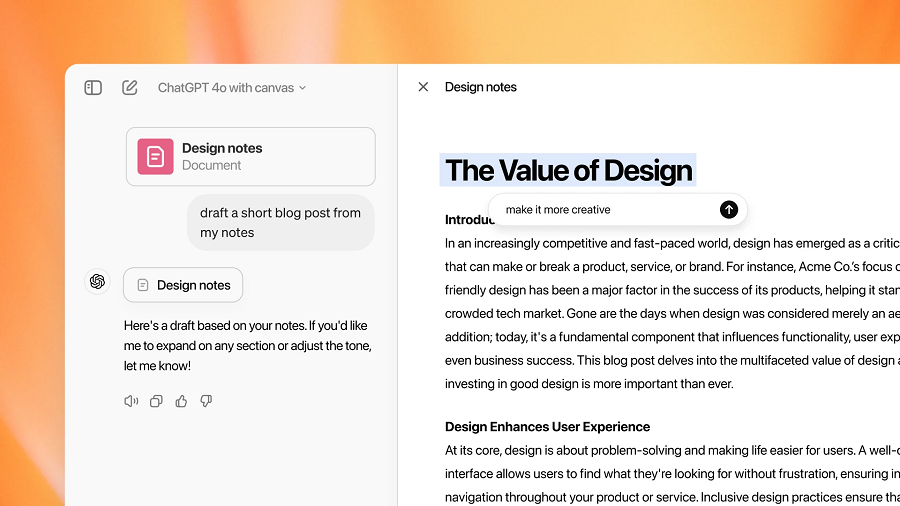 AI
AI
 AI
AI
 AI
AI
OpenAI is updating ChatGPT with a new interface section, called canvas, that promises to make the chatbot more useful for writing and coding tasks.
The company debuted the feature today. It marks OpenAI’s first product update since the announcement of its record-setting $6.6 billion funding round earlier this week. The deal included the participation of Microsoft Corp., Nvidia Corp., SoftBank Group Corp. and a half-dozen investment firms.
ChatGPT’s new canvas section resembles word processors such as Word in certain respects. It opens in a new window that is split into two parts. The first, larger section contains the text or code that the user is working on, while the second interface module is a sidebar that shows the user’s ChatGPT prompts and the chatbot’s responses.
OpenAI ships canvas with a set of features designed to speed up writing tasks. Users can ask ChatGPT to check their text for grammar, clarity and consistency. The chatbot is capable of automating more complex tasks as well: It can make a document shorter or longer and adjust the reading level.
The built-in programming features, in turn, mostly focus on helping users fix code issues. ChatGPT can generate print statements, snippets of code that display the data processed by a given application component. That data helps developers identify the root cause of technical issues. ChatGPT can also fix some bugs on its own, as well as point out other issues such as inefficient code that uses too much processor capacity.
After finalizing a code file, developers can ask canvas to generate documentation that explains how it works. Furthermore, the tool is capable of translating the file into other programming languages. Its code translation feature will support JavaScript, TypeScript, Python, Java, C++ and PHP output on launch.
Under the hood, canvas is powered by a modified version of GPT-4o. OpenAI developed the custom model using training data generated with o1, its newest artificial intelligence system. The latter algorithm is significantly better than GPT-4o at reasoning tasks such as solving math problems.
ChatGPT launches canvas automatically when it believes the feature may ease the user’s work. According to OpenAI, its engineers developed the custom version of GPT-4o that powers the feature partly to reduce unnecessary canvas activations. The company says that the customized model is 83% more reliable in that regard than the standard GPT-4o release.
Another goal of the development effort was to boost the quality of canvas’ AI-generated file edits. When a user selects a snippet of code or text in a file, the custom version of GPT-4 only edits that specific snippet. When the user doesn’t highlight any text or code, the model is more likely to make changes throughout the document.
According to OpenAI, the customized version of GPT-4o is also better at pointing out areas of improvement in users’ files. The company says comments generated by the model have a 16% quality advantage over output from GPT-4o.
OpenAI is releasing canvas in phases. The feature started rolling out to ChatGPT Plus and ChatGPT Team today and will become available in the Enterprise and Edu editions next week. Canvas will also become accessible to free users once it exits beta testing.
Support our mission to keep content open and free by engaging with theCUBE community. Join theCUBE’s Alumni Trust Network, where technology leaders connect, share intelligence and create opportunities.
Founded by tech visionaries John Furrier and Dave Vellante, SiliconANGLE Media has built a dynamic ecosystem of industry-leading digital media brands that reach 15+ million elite tech professionals. Our new proprietary theCUBE AI Video Cloud is breaking ground in audience interaction, leveraging theCUBEai.com neural network to help technology companies make data-driven decisions and stay at the forefront of industry conversations.